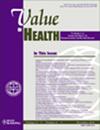Capturing the Additional Cardiovascular Benefits of SGLT2 Inhibitors and GLP-1 Receptor Agonists Beyond the Control of Traditional Risk Factors in People With Diabetes
IF 4.9
2区 医学
Q1 ECONOMICS
引用次数: 0
Abstract
Objectives
This study aimed to quantify the additional cardioprotective effects of sodium-glucose cotransporter 2 inhibitors (SGLT2is) and glucagon-like peptide-1 receptor agonists (GLP-1RAs) beyond the traditional risk factors control in individuals with type 2 diabetes. This helps calibrate the Building, Relating, Assessing, and Validating Outcomes (BRAVO) diabetes simulation model to capture the total cardiovascular benefits of new diabetes medications accurately.
Methods
We extracted patient characteristics and treatment efficacy data from 4 cardiovascular outcome trials (CVOTs) of SGLT2is and 4 CVOTs of GLP-1RAs completed before May 2023. Using the BRAVO diabetes simulation model, we translated reductions in traditional risk factors (ie, glycated hemoglobin, systolic blood pressure, low-density lipids, and body mass index) from the newer drugs into risk reductions in cardiovascular outcomes (ie, myocardial infarction [MI], stroke, congestive heart failure [CHF], and mortality), assuming that the drug-associated risk reductions were only driven by traditional risk factors. Then, we compared the simulated risk-factor-driven risk reductions of cardiovascular outcomes with observed risk reductions from the trials and calculated drug-specific incremental benefits (DIB).
Results
After accounting for the cardiovascular effects from traditional risk factors control, SGLT2is was associated with an additional 19% risk reduction in CHF (DIB: 0.81, 95% CI 0.72-0.90). Furthermore, the uncalibrated model predicted a risk reduction in stroke with SGLT2is, which was not observed in CVOTs. This discrepancy highlights the need for an SGLT2i-specific calibrator to align the simulation results with the observed outcomes. In contrast, no additional cardiovascular benefit was associated with GLP-1RAs after controlling for traditional risk factors.
Conclusions
Our study revealed that SGLT2is could further reduce CHF risk beyond the control of traditional risk factors but may offer additional pathways to offset the overall benefits of traditional risk factor control in stroke risk. No additional cardiovascular benefits were observed for GLP-1RAs beyond traditional risk factor control. The BRAVO model calibration enhances cardiovascular outcome prediction with these newer antidiabetic therapies.
获得SGLT2抑制剂和GLP-1受体激动剂在糖尿病患者传统危险因素控制之外的额外心血管益处
目的:本研究旨在量化钠-葡萄糖共转运蛋白2抑制剂(SGLT2is)和胰高血糖素样肽-1受体激动剂(GLP-1RAs)在2型糖尿病(T2D)患者中除传统危险因素控制外的额外心脏保护作用。这有助于校准BRAVO糖尿病模拟模型,以准确捕获新的糖尿病药物对心血管的总体益处。方法:我们从2023年5月前完成的4项SGLT2is心血管结局试验(CVOTs)和4项GLP-1RAs心血管结局试验(CVOTs)中提取患者特征和治疗疗效数据。使用BRAVO糖尿病模拟模型,我们将传统危险因素(即糖化血红蛋白;收缩压;低密度脂质;假设与药物相关的风险降低仅由传统风险因素驱动,则将较新的药物与心血管结局(即心肌梗死(MI)、中风、充血性心力衰竭(CHF)和死亡率)的风险降低联系起来。然后,我们将模拟的风险因素驱动的心血管结局风险降低与试验中观察到的风险降低进行了比较,并计算了药物特异性增量获益(DIB)。结果:在考虑了传统危险因素控制的心血管影响后,SGLT2is与CHF风险降低19%相关(DIB: 0.81, 95% CI: 0.72-0.90)。此外,未经校准的模型预测了SGLT2is患者卒中风险的降低,这在cvot中没有观察到。这种差异强调了需要一个sgltti专用校准器来将模拟结果与观察结果对齐。相比之下,在控制传统危险因素后,GLP-1RAs并没有带来额外的心血管益处。结论:我们的研究表明,SGLT2is可以进一步降低传统危险因素控制之外的CHF风险,但可能提供额外的途径来抵消传统危险因素控制对卒中风险的总体益处。除了传统的风险因素控制外,没有观察到GLP-1RAs对心血管的额外益处。BRAVO模型校准增强了这些新的抗糖尿病治疗的心血管预后预测。
本文章由计算机程序翻译,如有差异,请以英文原文为准。
求助全文
约1分钟内获得全文
求助全文
来源期刊

Value in Health
医学-卫生保健
CiteScore
6.90
自引率
6.70%
发文量
3064
审稿时长
3-8 weeks
期刊介绍:
Value in Health contains original research articles for pharmacoeconomics, health economics, and outcomes research (clinical, economic, and patient-reported outcomes/preference-based research), as well as conceptual and health policy articles that provide valuable information for health care decision-makers as well as the research community. As the official journal of ISPOR, Value in Health provides a forum for researchers, as well as health care decision-makers to translate outcomes research into health care decisions.
 求助内容:
求助内容: 应助结果提醒方式:
应助结果提醒方式:


